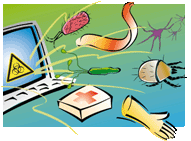Burning accident when working with metalorganic compounds
Fatal burning in a laboratory
In a chemical laboratory, a severe explosion occurred when carrying out the reaction of a metalorganic compound with butyllithium in tetrahydrofuran. An employee suffered serious burns in the process. Despite the efforts of the emergency services and subsequent treatment in a special clinic for those suffering from severe burn injuries, the employee died a few days later as a result of the severe burns.
It was assumed that the explosion was caused by a mixture of isopropanol and air, among other factors. To cool down the reaction, which took place in a Schlenk tube with a volume of approx. 200 ml content in nitrogen, a mixture of isopropanol and dry ice was used. Due to the severity of the explosion, the fact that another employee suffered acoustic trauma and the fact that the temperature of the liquid in the container was probably below the flashpoint of isopropanol, the aforementioned theory was excluded. The actual cause of the accident is currently unknown.
The victim would probably not have suffered fatal injuries had he been able to start either the safety shower (emergency shower) or the fire extinguisher: there was a safety shower in front of the door of the laboratory. The shut-off valve could be actuated via an angled lever, at the end of which were long chains. After pulling the chain that was hanging lowest with no success, it tore off. Next, the victim attempted to use a fire extinguisher on himself – also without success. He then ran out of the laboratory and into the corridor, where the fire was finally put out. After the event it was established that both the safety shower and the fire extinguisher were operable. In the case of the safety shower, however, it was necessary to pull the higher chain to open the valve and, for the fire extinguisher, the guard pin (splint) had to be released by pulling on the ring.
Section 6.6.1 "Emergency (overhead) showers" of the laboratory guidelines stipulates, among other things, that the direction of opening (of a fast-opening valve) must be easily recognisable. In the aforementioned case, the valve should have opened at least when the lower chain was pulled. The installation of just one chain would have been better still, although chains for opening shut-off valves have not stood the test of time as chains can be ripped off when pulled suddenly. For instance, a pull rod would have been better than a chain. The installation of the chain or the pull rod above doors is also not recommended within the context of the aforementioned section, as only tall people can then open the valve.
If a lever is used to open the shut-off valve, the shut-off valve must be fully open after turning the lever 90° at the latest (DIN 12 899, Part 1 "Laboratory equipment; Emergency shower equipment; Safety showers; Safety requirements and inspections").
Furthermore, the safety showers should immediately cover all parts of the body with a sufficient quantity of water. Previously, 20 l/min were required. In future, at least 30 l/min are stipulated. The aforementioned DIN standard also requires that at a height of 1.5 metres above the floor, at least 50% of the water stays within a circle with a diameter of 20 cm. The total covered area must not exceed a circle with a diameter of 40 cm at this height. To prevent calcification of the shower head, this must automatically be emptied to the greatest possible extent after use.
Finally, once the valve has opened, it must not close again of its own accord.
Moreover, the function of safety showers must be checked at least once a month. To ensure that this inspection takes place, a responsible person must be named, as required in the revised laboratory guidelines.
If work needs to be carried out on the piping of safety showers, this may only be performed following consultation with the laboratory head.
The "mobile" emergency showers available on the market are no substitution for permanently installed safety showers, as the requirements of section 6.1 of the laboratory guidelines and DIN 12899, Part 1 are not met. Mobile emergency showers can be used where only minor burns are possible and where no running water is available.
The fact that the victim failed to use the fire extinguisher indicates that he was not familiar with its operation. Theoretical knowledge of how to start fire extinguishers on its own is not sufficient to familiarise staff with their use; instead, prior practical fire extinguishing exercises, for instance using the fire extinguishers in the laboratory, is required.
Moreover, it should be checked whether an extra action, e.g. pulling the guard pin, is necessary. It has been suggested that the guard pin is designed in such a way that it breaks when the extinguishing lever is pressed strongly, thereby "releasing" the fire extinguisher.
The aforementioned chemical reaction was carried out on the laboratory bench next to a fume hood: as new compounds with unknown hazard potential were created in the process, the reaction should have at least taken place behind a robust protective screen that is secured against falling over. Working in the fume hood is safer still, on the condition that the sash window is closed. In future, work may only be performed with the sash window open with the permission of the laboratory head, as when the sash window is open, more hazardous substances escape and the user of the fume hood is not protected against splashes of hazardous substances or flying glass fragments.
See: Sichere Chemiearbeit 6-1992, p. 70
You can reach the German-language version of the article with a single click on the flag-symbol.








